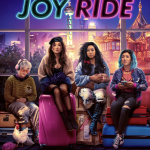The Lamberts must go deeper into The Further than ever before to put their demons to rest once and for all.
Chuck says:
I’ve made no bones about how I feel about the third acts of most Hollywood films. So many of them don’t follow through to a logical conclusion or they march lockstep towards an ending that’s woefully predictable. However, there have been some encouraging signs of late. “The Flash” brought to a close a troubled movie multiverse with plenty of fan service, as well as heart, without compromising itself or skimping on fun, while “Indiana Jones and the Dial of Destiny” provided a perfect grace note for the titular globetrotting archeologist. Even TV’s “Ted Lasso,” despite limping through a lackluster third season, managed to stick the landing with a genuinely poignant conclusion that reminded viewers of why they fell in love with the show in the first place.
Add Patrick Wilson’s “Insidious: The Red Door” to the list of recent productions with satisfying endings, as this final part in the horror franchise manages not simply to rehash key elements from previous entries but explores more deeply its key themes while delivering an emotionally charged conclusion to the Lambert family saga. Though the first-time director allows things to sag a bit in the middle, overall, this is an effective thriller that provides some genuine scares for horror fans as well as a solid exploration of its subtext.
Events pick up some ten years after the events of the second film in the series, though things are far from rosy. Josh’s (Wilson) mother, Lorraine (Barbra Hershey) has died, and her funeral is the awkward meeting place for the Lambert clan. Josh and Renai (Rose Byrne) have divorced, and as a result their eldest son Dalton (Ty Simpkins) harbors a deep resentment towards his father. Going off to college, the young man is a bit of an outcast, yet expresses himself forcefully through his art. An in-class exercise, in which the students are encouraged to draw something plucked from their memories, prompts Dalton to furiously render a picture of a red door, for reasons he cannot comprehend. Meanwhile, complaining that his memory is foggy, Josh submits to some tests to chart his brain activity. This too elicits some disturbing events from his subconscious that cause him to question his sanity.
What Josh and Dalton don’t realize is that after their journey into the Further – a haunted realm populated by tortured souls accessed through astral projection – some ten years prior, they were both hypnotized and told to forget about this experience. While this narrative switchback smacks of convenience, Wilson doesn’t dwell on it and moves the story briskly along to one disturbing scene after another. Seems some rather nasty spirits have been waiting for them both to return and are starting to invade our realm in order to pull them in.
Wilson delivers three very effective jump scares – yeah, he got me eachtime – which isn’t all that difficult to do. However, where he excels is not simply replicating the eerie nature of The Further but presenting it in the same space as our world. These two dimensions overlap for the first time in the franchise, a seemingly simple piece of staging that effectively increases the tension as it puts father, son, and those they love in more immediate danger. Quick cutting and jarring camera movements increase the sense of displacement and confusion, all of it done practically and in camera. Again, what Wilson isn’t complicated, but it’s done well and this old school approach proves refreshing.
At the core of the “Insidious” films have been the themes of guilt and denial, both of which severely affect Josh’s mental health and now his son’s. The narrative conceit that the sins of the father will be visited upon the son is the engine that drives the story, obviously through the conflict that exists between Josh and Dalton but from another surprising source as well, one that hearkens back to the original film and allows for closure for both the characters and the franchise.
To be sure, the “Insidious” movies will never be mistaken for works of great originality. However, what James Wan and Leigh Whannell have done from the beginning is produce, on modest budgets, well-crafted, old-fashioned fright films that provide effective jolts using the most basic cinematic tools and techniques, along with just enough thematic heft to elevate them above the usual genre fare. Wilson should be commended for continuing this tradition, “The Red Door” being a fitting swan song.
3 Stars




